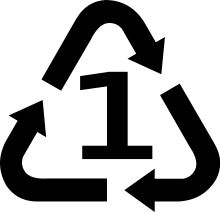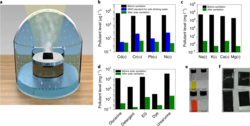Solar water disinfection
The SODIS method uses a combination of UV light and increased temperature (solar thermal) for disinfecting water using only sunlight and repurposed PET plastic bottles.
Colourless, transparent PET water or soda bottles of 2 litre or smaller size with few surface scratches are selected for use.
Bottles will heat faster and hotter if they are placed on a sloped sun-facing reflective metal surface.
After sufficient time, the treated water can be consumed directly from the bottle or poured into clean drinking cups.
[2] SODIS is an effective method for treating water where fuel or cookers are unavailable or prohibitively expensive.
However, supplying bottles may be more difficult than providing equivalent disinfecting tablets containing chlorine, bromine, or iodine.
Other methods for household water treatment and safe storage exist, including chlorination, flocculation/disinfection, and various filtration procedures.
[6][7] Recent work has shown that common table salt (NaCl) is an effective flocculation agent for decreasing turbidity for the SODIS method in some types of soil.
If the sunlight is less strong, due to overcast weather or a less sunny climate, a longer exposure time in the sun is necessary.
Follow-up was conducted by the research groups of Martin Wegelin at the Swiss Federal Institute of Aquatic Science and Technology (EAWAG) and Kevin McGuigan at the Royal College of Surgeons in Ireland.
Clinical control trials were pioneered by Ronan Conroy of the RCSI team in collaboration with Michael Elmore-Meegan.
[27] A 2008 study showed that powdered seeds of five natural legumes (peas, beans and lentils)—Vigna unguiculata (cowpea), Phaseolus mungo (black lentil), Glycine max (soybean), Pisum sativum (green pea), and Arachis hypogaea (peanut)—when evaluated as natural flocculants for the removal of turbidity, were as effective as commercial alum and even superior for clarification in that the optimum dosage was low (1 g/L), flocculation was rapid (7–25 minutes, depending on the seed used) and the water hardness and pH was essentially unaltered.
[29][30] Other research has examined the use of doped semiconductors to increase the production of oxygen radicals under solar UV-A.
In isolated regions the effect of wood smoke increases lung disease, due to the constant need for building fires to boil water and cook.
Research groups have found that boiling of water is neglected due to the difficulty of gathering wood, which is scarce in many areas.
[34][35] The Swiss Federal Institute of Aquatic Science and Technology (EAWAG), through the Department of Water and Sanitation in Developing Countries (Sandec), coordinates SODIS promotion projects in 33 countries including Bhutan, Bolivia, Burkina Faso, Cambodia, Cameroon, DR Congo, Ecuador, El Salvador, Ethiopia, Ghana, Guatemala, Guinea, Honduras, India, Indonesia, Kenya, Laos, Malawi, Mozambique, Nepal, Nicaragua, Pakistan, Perú, Philippines, Senegal, Sierra Leone, Sri Lanka, Togo, Uganda, Uzbekistan, Vietnam, Zambia, and Zimbabwe.
SODIS has also been applied in several communities in Brazil, one of them being Prainha do Canto Verde, Beberibe west of Fortaleza.
[citation needed] One of the most important things to consider for public health workers reaching out to communities in need of suitable, cost efficient, and sustainable water treatment methods is teaching the importance of water quality in the context of health promotion and disease prevention while educating about the methods themselves.




